
|
Note ye ed's email address: stevebryant99@gmail.com. |

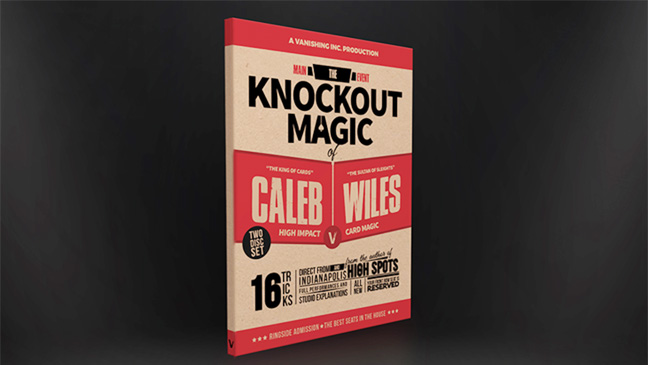
Smashing!
|
Return to our April issue for a look at The Magic of Johnny Thompson, at Harry Lorayne's Jawdroppers lecture, and at the amazing life of Harry Anderson. 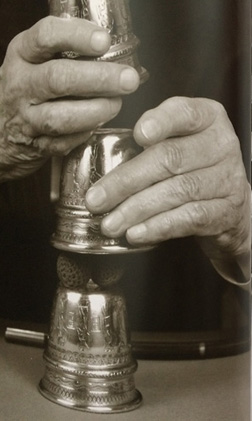 J.T. cups and balls. |
May 2018 The magic this month is special: a four-hour lecture from Caleb Wiles, showcasing 16 of his best card tricks. Vanishing, Inc. continues to churn out top-quality material. Ah, youth. On a sad note, I'm not finished with Harry Anderson just yet, and I hope I never will be. He was a tremendous influence and perhaps more than anyone proved that magic could be cool. Adding to last month's comments, we take a look at Harry's four-hour lecture from Penguin LIVE, a retrospective look at Harry's and Jon Racherbaumer's Jinx tribute, a few links to must-see Harry Anderson online clips, and at the promising future of Harry's high school days. This month's issue is appearing a little early, so I hope you didn't miss last month, with a review of the fantastic Johnny Thompson books, a review of a five-dollar Harry Lorayne lecture, and my initial thoughts on the loss of Harry Anderson. The new house is coming along nicely, thank you, and I'll close with a look at how a magician flattens a new carpet. |
|
|
TKO -- Back in March 2007*, I drove up to Indy for the tandem T&A lecture by Tyler Wilson and Andi Gladwin. Opening for the boys was a local college student, Caleb Wiles, with his first lecture and what would prove to be a defining moment in close-up card magic. Then and now Caleb is a creative force and an entertaining performer at home at a table of the world's best in a Magi-fest lobby, commanding a large room of $100 a pop audience members, or fooling Penn & Teller. His latest project, a hot Vanishing, Inc. seller, is his four-hour lecture available as DVD or download (or both). Main Event: The Knockout Magic of Caleb Wiles is a smashing collection of 16 tricks, some of which had previously appeared in Caleb's books High Spots and Six Pack. Do not let that deter you, especially if you already own those books. More than anyone else I know in magic, Caleb is constantly fiddling with his methods, constantly improving them. Radically improving them, and that is certainly the case here. All magic in Caleb's world is a work in progress. A few giant killers: CLUE is Caleb's ingenius solution to the Genii challenge to come up with an effect that invokes Paul Harris's Pointer Anomaly Principle. No matter how the spek turns the cards over, the cards labeled C-L-U-E lead him to his selection, then all the CLUE cards become mates of the selection. Make a Wish harkens back to Caleb's first lecture, when I had hailed it as "a birthday trick of extraordinary potential, almost as strong as Anniversary Waltz." It still is, a charming routine in which you blow out the candles on a spek's birthday card. Among the radical improvements is a means of doing the trick any time a spek mentions that today is his birthday.  Mia reacts. Here A Move ... is a four-phase routine that begins as an Elevator trick, then becomes Twisting the Aces, then the aces turn red one at a time, then back to blue one at a time. A version had appeared in High Spots, but the addition of Joshua Jay's Elevator sequence puts you sooo far ahead. Lucky Shuffle is an impossible coincidence effect, mostly happening in the spek's hands, reminiscent of Caleb's 26! (26 Factorial) trick. Caleb had shown me versions of this over the years, but he always had to gather various pairs of cards to get into the trick. He finally solved it by ripping 11 random cards, a la the popular Woody Aragon trick. Voila! You now begin with 22 paired cards. Armchair Mind Reading buckled my knees. This may be one of the most direct mind reading effects with a deck of cards ever. A version had appeared in Six Pack, but the improvements since then will make you believe in mental telepathy. There is just no way. My favorite routine in the set.  Ryan's card is a red card. Production values are first-rate, with high res video, nicely captured audience reactions, and clear, succinct explanations. The Credits segment was charming, with laudable references and a truly catchy sound track. From Vanishing, Inc., $40 for DVD or download, or $45 for both. I opted for the download direct from the publisher. (*Extraneous note: In the same March 2007 issue in which I introduced Caleb Wiles, I reviewed Harry Lorayne's Best of Friends III. I asserted that it would be Harry's last book. So wrong!) |
|
|
I'm still quite bummed over Harry Anderson's demise and have accordingly been doing what I can to catch up on him. My starting point was his four-hour Penguin lecture, which I hadn't seen. I revisited his amazing Jinx insert to Genii and read each article in detail, for the first time. (I had skimmed it in 2009 and forgot to go back and spend more time with it.) There are plenty of YouTube clips and other sources on the internet, and I've been perusing them. Finally, I went back to Harry's high school yearbook to discover what a promising student he was. Wow. Full details below. THE PENGUIN LECTURE -- Harry Anderson performed his Harry Anderson LIVE lecture for Penguin November 4, 2012, with Nathan Kranzo as host. (Nathan's persona and material have often evoked Harry's to me, hence a great choice as host.) As with all the Penguin lectures, it's still available, a delightful 231-minute visit that flies by. 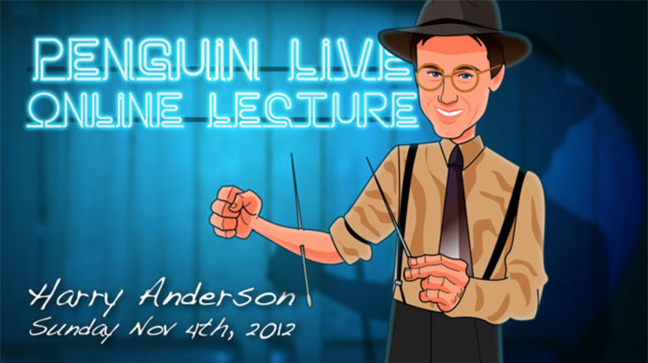 Four hours of magic. The magic opens with Wise Guy Monte, with the jumbo cards, the trick that earned Harry an opening spot for Kenny Rogers and all the fame that followed. Via the tricks he reveals, Harry explains the difference between conceit and instantiation. The worst conceit: "I know something you don't know." Better conceits: "Human thoughts can be shared" or "Gravity isn't a law ... it's an agreement." The instantiation is the trick itself that puts the conceit or premise across. 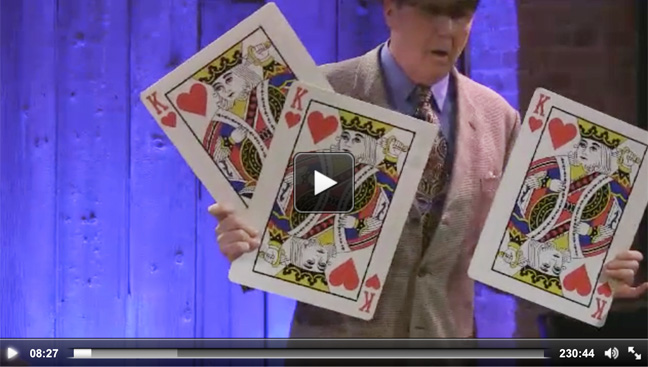 What are the odds? Other secrets: The Last Monte, The Gang of Four, Where's Tom? (an optical puzzle with a two-dollar bill), Big Money, the 21-Card Trick, Cuff Links (why the Irv Weiner thumb tie routine sucks), a card counting routine (uses the Aronson stack), Grant's Million Dollar Bill Mystery, and the folding Magic Square routine. Talking points and revelations during the magic portion: How to make it OK to fall into a wife's breasts while performing a straitjacket escape. Belonged (with Paul Harris, Paul Green) to the Dante magic club at 14, run by Dante's son with lectures by Charlie Miller, Kuda Bux, and Dai Vernon. Attended Nobel junior High which had a complete file of Genii: you could check out the girls in the Himber ads in study hall. At the 143-minute mark, the magic portion of the lecture concludes and Harry sits down with Nate Kranzo to field questions from Nate, from live online viewers, and from the studio audience. This, for me, is where the lecture catches fire.  Harry and Nathan chat ... for the ages. Of the many things discussed: Life in Chicago emptying ashtrays for old card players in Bert Allerton's Pump Room. The night he played the card game Klabiash for six hours with George Burns. Admitting to never being much of a con man, despite working the Garcia shell routine on the streets at 16. Developing long routines to hold a crowd during street magic. The time Pete Fountain called the cops on him in New Orleans ... and meeting Pete later on the Carson show. On a trip to check out Berkeley for college went to Buma's House of Magic, bought some stuff, started working the streets, never looked back. Met Martin Lewis as an instant stooge at Earthquake McGoon's. As a child saw Blackstone perform. Becoming famous: two weeks that changed everything. Is Markie Post's bust real? Ballantine as an influence. Appeared on Carson 11 times. How he cheated Vernon at gin at the Magic Castle. Performing his old two-person mental act with his daughter, on his 60th birthday at the Castle. Receiving the guinea pig cage from Danny Dew, who said, "Don't do it." Doing it. Performing "Scare the Dickens" at Rich Bloch's Dickens theater. Johnny Carson being sweetly nervous performing coin magic for him. Close friendships with Jon Racherbaumer and Meir Yedid. His glasses had no lenses. Book recommendation: Harry Lorayne's Close-Up Card Magic. Dining with Harry Lorayne while someone needed the Heimlich. Worst moment on stage. Untying Slydini knots with his tongue. Was covered with tattoos but left one forearm "clean" in case he reprised Needle Through Arm. Had a foster brother. His fedora collection was ruined by Katrina. Lost a fortune through divorce and Katrina, but fortunately made two. And when Nate asked if he performs close-up, Harry stood and performed a hilariously vulgar coin routine. Just wonderful memories and philosophies. All for $29.95 as a download from penguinmagic.com. Your opportunity to spend a little more time with Harry Anderson. HIGH JINX -- October 2009 was a signature issue for Genii, thanks to its 32-page Jinx insert from Harry Anderson and Jon Racherbaumer. It has been a while since I had looked at it, and Harry's passing gave me reason to revisit. It's just a marvelous, brilliant tribute. I particularly enjoyed Harry Anderson's and Jon Racherbaumer's "Anything Went" (a look at Ted Annemann and 1934), David Ben's "And the Oscar Goes To ..." (a billet switch routine), Stephen Minch's "Who Do You Thrust?" ( a model of magical scholarship), Max Maven's "The Rabbit Hole of No Return" (a look at Annemann's performing chops), Jonathan Levit's "Simply the Best" (Annemann's perfect second deal anyone can do), Michael Weber's "Durer Had a Word for It" (looks like a magic square routine but isn't), Eugene Burger's "When the Cats Hissed" (biting reviews by Annemann of his contemporaries), Eddie Fields' "Crissorc" (a surprise-ending ESP effect), and Mike Caveney's "Unfettered Letters" (a "Classic Correspondence" satire centered on an Annemann letter). I may as well list them all; each had special merit. I especially liked the Ropes of Mystery gag on the Fun Page. 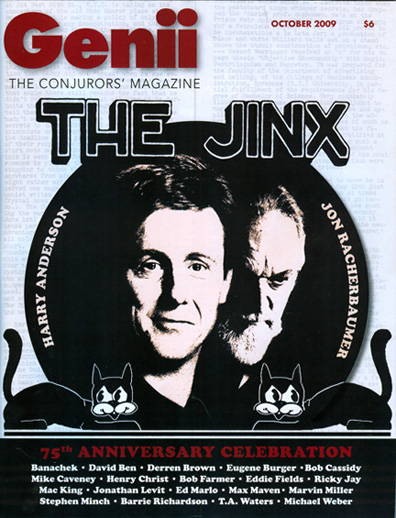 Harry makes the cover of Genii. Genii subscribers can turn to the issue at will. For the context, here is the news blurb I published back in the day, under the heading "Catnip": Every so often, extraordinary people do extraordinary things. Such was the case this year when Harry Anderson and Jon Racherbaumer decided to produce a 75th anniversary issue of The Jinx, enlisting along the way contributions from magic's creme de la creme. As I mentioned in The Little Egypt Book of Ghosts, I could have had a happy life in magic performing material exclusively from Annemann's Practical Mental Effects, which is to say from The Jinx. It was therefore a great personal treat to receive a new issue in the mail, an issue apparently banged out on an old Underwood and pasted together with real paste. Harry Anderson's time on the learning curve of Adobe InDesign was well spent. Richard Kaufman made room for this 32-page retro issue within the October issue of Genii, hence it arrived free to subscribers. (The insert alone will also be made free to new subscribers.) Annemann would have been proud of what Harry calls this "remarkable 32-page duty-free birthday card," an artsy melange of tributes, retrospectives, history, humor, haiku, and, especially, clever and practical new mentalism. This is an issue for the ages. Our collective thanks to Harry, Jon, and all involved. SURF'S UP -- And of course, you can surf the internet for clips of Harry Anderson performing. A few of my favorites: An early appearance on TV with Elvira Appearances on "Late Night with David Letterman 82-87" 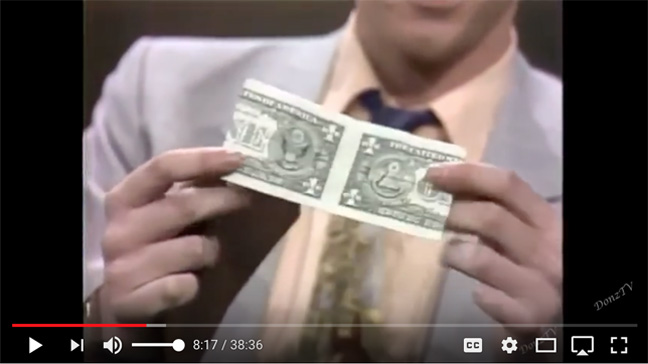 Almost restored.  Let's talk geek. 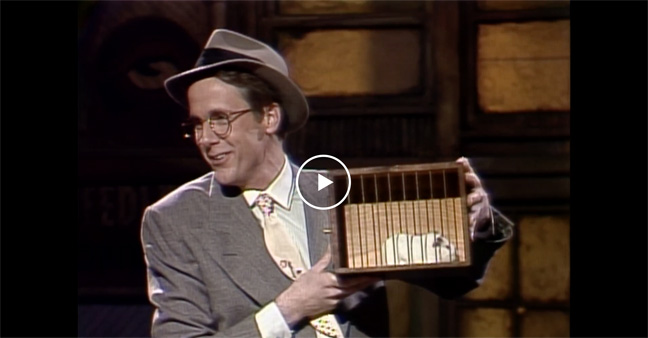 Harry and Skippy. |
|
AND THE MAGIC EIGHT BALL SEES -- The Harry Anderson bio I referenced last month mentioned that Harry moved, at 16, to Los Angeles, where he attended high school and graduated valedictorian. Given Harry's nomadic life prior to that move, I found it impressive both that Harry earned the honor and that his school would bestow it on a transfer student. A check on his Class of 70 North Hollywood High School yearbook confirmed the story and cast Harry as a model student with a bright future. He was not only valedictorian, back in the days when schools tended to confine that honor to one student, but racked up additional academic honors as well: National Merit Finalist, National English Teachers Award, Sweepstakes Winner Forensics League Orange County (the league is a speech and debate association), and California Scholarship Federation four semesters (the CSF recognizes California students who possess high academic standards).  High school yearbook photo. He also found time for Varsity Tennis, to direct and star in "J.B." (the Archibald MacLeish play about the biblical figure Job), and to be a Boys' State representative. Yearbooks love to share their students' plans, and for Harry that included attending school at Berkeley and then NYU, majoring in Theatre Arts. Although the path didn't work out quite like that, the final destination was probably more than the young artist hoped for. North Hollywood High thrives today, serving as the state's only Highly Gifted Magnet school and boasting such celebrity alumni (along with Harry) as Alyson Hannigan, Scott Baio, Teri Garr, Brian Austin Green, Susan Sontag, John Williams, Martin Milner, Nick Cassavetes, Shelley Fabares, Cuba Gooding Jr., and Alan Ladd, among many others. It seems the sort of place that a young, brainy, talented lad such as Harry Anderson would still fit in nicely. |
|
 How to flatten a rug.
Spend some time with your mom.
Follow us on Twitter. Little Egypt Magic is the erratically updated web site of Steve Bryant, spawned (the site, not Steve) by a former internet magazine known as The Little Egypt Gazette/for magicians only. Steve Bryant is an obscure magician and writer who generates this site from an iMac in Bloomington, Indiana. He used to frequently journey to and perform magic in Little Egypt, the local name for extreme southern Illinois, where the towns bear such names as Cairo, Thebes, and Karnak. Past issues of this web site: Index to Past Issues Notice: Any limited use of copyrighted images or quoted text is considered fair use, usually to review whatever product or event that is under discussion. If you object to use of any material, please get in touch and it will be cheerfully removed. |
A JSB Creations product
Copyright© 2018 by Steve Bryant